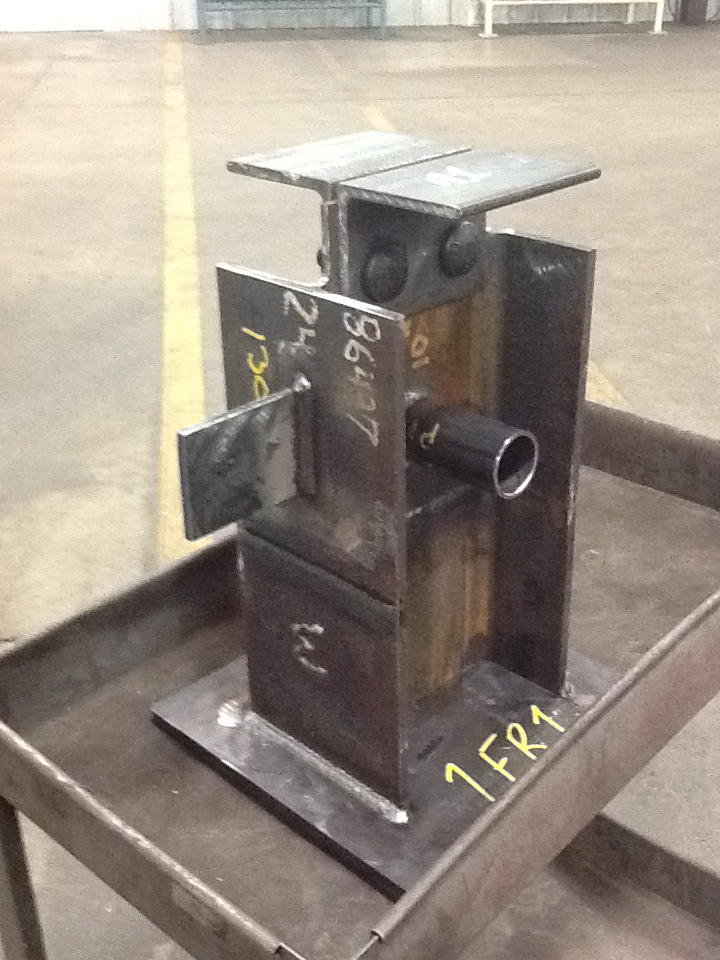Title Page
-
Audit Process- Steel Erection
-
Company
-
Conducted on
-
Prepared by
-
Location
Erector Program Requirments
-
PR 8-9 -10 Is there an active jobsite with at least 3 functions available for assessment (project planning, material receipt, hoisting, alignment, final connection (bolting and welding),safety, and project records)?<br>
-
PR-12 Does the participant demonstrate that its QCI (as defined in Chapter N in ANSI/AISC 360 - 2010) document QCI qualifications, experience and training in their QM that they are qualified per all applicable codes for erection functions?<br><br><br>
5.0 Management Responsibility
5.1 Commitment (Policy)
-
5.1. Policy for Quality
-
Is there a Quality Policy with a commitment to quality that includes a commitment to meet contract requirements, communication quality goals and a commitment to training?
-
Are there Quality Management System objectives that provide a framework for establishing and reviewing quality goals of the Erector's organization?.
-
Are there specific measurable quality goals?
-
Are specific measurements related to goals being recorded?.
-
Are current goal achievement levels known relative to a previous measurement or baseline?.
The policy for quality shall include:
A commitment to quality that includes a commitment a.
to meet contract requirements.
A quality management system that provides a frame-b.
work for establishing, communicating and reviewing
quality goals of the erector’s organization.
A commitment to training.c.
Executive management shall establish goals to improve
quality. Goals must be measurable and documented
through objective evidence.
As quality goals are achieved, new goals shall be set that
demonstrate commitment to continuous improvement.
New goals can be a new level of achievement of a pre-
vious goal, or a new goal that has not been previously
identified.
Executive management shall ensure that the com-
pany’s policy for quality is understood, implemented
and maintained.
5.2 Policy for Safety
-
5.2. Policy for Safety
-
Is there a Safety Policy with a commitment to quality that includes a commitment to safety that includes at a minimum a. <br>a commitment to meet federal and/or state require-ments for construction safety and a commitment to Safety training?<br><br>
-
Are there Safety Management System objectives that provide a framework for establishing and reviewing quality goals of the Erector's organization?.
-
Are there specific measurable Safety goals?
-
Are specific measurements related to goals being recorded?.
-
Are current goal achievement levels known relative to a previous measurement or baseline?.
The policy for safety shall include:
A commitment to safety that includes at a minimum a.
a commitment to meet federal and/or state require-
ments for construction safety.
A safety management system that provides a frame-b.
work for establishing, communicating and reviewing
safety goals of the erector’s organization.
A commitment to safety training.c.
Executive management shall establish safety goals. Goals
must be measurable and documented through objective
evidence.
As safety goals are achieved, new goals shall be set that
demonstrate commitment to continuous improvement.
New goals can be a new level of achievement of a pre-
vious goal or a new goal that has not been previously
identified.
Executive management shall ensure that the com-
pany’s policy for safety is understood, implemented
and maintained.
5.3 Periodic Management Review
-
A. Summary of previous management reviews?
-
B. Review of results of Internal and External Audits.
-
C. Assessment of customer feedback and feedback mechanisms.
-
D. Assessment of erected steel non-conformances, number and severity.
-
E. Assessment of compliance with QMS and SMS procedures.
-
F. Asessment of the results of equipment inspections, including the adequacy of equipment resources.<br><br>
-
G. Assessment of the adequacy of the erector’s training program with respect to the levels of qualification <br>required.<br><br>
-
H. Assessment of any proposed or required modifications to the quality management system and safety <br>management system.<br><br>
5.4 Responsible Quality and Safety Personnel
-
Executive management shall designate management representatives for quality and safety who shall
directly to (or be a part of) executive management.
The designated management representatives for quality
and safety may perform other functions within the com-
pany, provided that those functions do not conflict with
the quality and safety responsibilities.
The designated management representative(s) shall have
the ability, responsibility and authority to:
Ensure that documented procedures needed for the a.
quality and safety management systems are estab-
lished, implemented and maintained in accordance
with this Standard.
Report to executive management on the performance b.
of the quality management system and safety man-
agement system and any need for improvement.
Communicate with external parties on matters relat-c.
ing to the quality management and safety manage-
ment systems.
5.5 Resource Management
-
The erector shall have the resources necessary to comply
with the contract documents. Resources shall include, but
are not limited to, the resources described below.
5.5.1. Personnel
Personnel performing defined functions shall have the
required qualifications and the ability to successfully
perform the function. Objective evidence of quali-
fication may be demonstrated through biographies,
resumes, documented training, and individual licenses
or certifications.
Personnel may be assigned to more than one function,
provided they are qualified and able to perform fully
the duties of each position.
5.5.2. Erection tools and Equipment
The erector shall have under their control the tools and
equipment necessary to perform the work. Equipment
must be maintained at the level necessary to produce
the required quality.
5.6 Quality Management System - Quality Manual - Organization - Approval
-
5.6. Quality management System
5.6.1. General requirements
The quality management system shall satisfy all of the
requirements of this Standard and the requirements of
the approved construction documents and referenced
standards.
The quality management system shall include a qual-
ity manual, documented procedures and records as
required by this Standard.
Requirements may be satisfied in a single document
called the quality manual which may incorporate sepa-
rate documents by reference.
Commentary:
The extent of the quality management system docu-
mentation can differ from one organization to another
due to the size of organization, the type of activities,
and the complexity and interaction of processes.
5.6.2. Quality manual
The quality manual shall contain the following:
Documented statements of a quality policy and a.
quality objectives as required by this Standard.
b.
management system (or references to them), along
with their associated quality records.
Documents needed by the organization to ensure c.
the effective planning, operation, and control of its
processes.
Organizational chart describing the interrelation-d.
ship of functional positions that manage, perform,
and verify work affecting quality.
Job descriptions outlining responsibilities, author-e.
ity and required qualifications for key positions.
Qualification evidence and biographies for indi-f.
viduals in key positions/functions.
Equipment list.g.
Executive management shall define additional docu-
mented procedures, drawings or other documents that
are required beyond the minimum requirements set by
this Standard to meet the needs of the erector’s organi-
zation and its customers.
Commentary:
The erector’s management determines the level of
detail in the quality manual and procedures. At a min-
imum, these documents should be detailed enough to
adequately describe the quality management system
used by the erector to assure the end work meets the
required quality.
5.6.2.1. organization
The quality manual shall include a page showing
the current revision date and the name and address
of the erector.
5.6.2.2. Approval
The highest ranking member of executive manage-
ment shall sign and date the quality manual.
5.7 Safety Management System - See Element 20
6. Construction Document review and communication.
-
Does the organization have a Documented Procedure? Is it being followed?
-
Are Records generated? (Eg Contract Review form)<br>
8.0 Control of Documents
-
Does the organization have a Documented Procedure for control of documents
-
Reviewed and approved?
-
Revision Controlled?
-
Is there Access to the required Documents?
-
Are changes and revision communicated?
8.2 Project Documents
-
Receiving control
-
Revision Control
-
Readily available and accessible?
-
Are erection and shop drawings and specs at site of erection?
9.0 Control of Quality Records
-
Does the organization have a Documented Control of Quality Records Procedure?
-
All quality records are stored in a way that prevents damage, deterioration or loss? Including electronic records?
-
Are Records accessable in a reasonable period of time?
10.0 Purchasing
-
Does the organization have a Documented Purchasing Procedure?
10.1 Purchasing Data
-
Are Materials and Services purchased per applicable codes and specifications?
-
Are Written purchasing documents employed?
10.2 Selection and evaluation of Subcontractors and Suppliers
-
Does the organization evaluate suppliers and subcontractors of both materials and services?
11.0 Material Identification
-
Does the organization have a Documented Material Identification Procedure?
12.0 Erection Process Control
-
Does the erector have documented procedures necessary to produce a consistent acceptable level of Quality?<br><br>
12.1 Welding
-
Are welders qualified to Processes and Positions being used?
-
Welding Machines are Maintained regularly per applicable code?
12.2 Bolt Installation
-
Does the organization have a Documented Bolt Installation Procedure including PIV and/or ROCAP?
-
Is pre-installation verification completed prior to installation per RCSC or applicable code by the bolting crew or designated QCI?
13.0 Inspection
-
Does the organization have a Documented Inspection and Testing Procedure consistent with Chapter N?
-
Are QCIs qualified?.
-
Does the organization utilize a sampling plan?.
-
Do the welding inspectors perform 100% VT?.
-
Do the welding inspectors have their eye tests on file?
14.0 Calibration of Inspection, Measuring and Test Equipment
-
Does the organization have a Documented Calibration Procedure? Is it being followed?
15.0 Control of Nonconformance's
-
Does the organization have a Documented Nonconformance Procedure?
-
Is non-conforming work recorded?
16.0 Corrective Action
-
Does the organization have a Documented Corrective Action Procedure?
-
Is the Corrective action process initiated when required by the standard?
17.0 Handling, Storage & Delivery of Product and Materials
-
Is material handled per AISC COSP?
18.0 Training
-
Does the organization have a Training Methodology?
-
Are training records maintained and include date, who attended, course outline and instructor?
19.0 Internal Audits
-
Does the organization have a Documented Internal Audit Procedure?
-
Is ther ea record of internal audits, including date(s) and those who performed the internal audit(s) of each element of the standard?
20.0 Safety Management System
20.1. Documentation Requirements
20.1.1. Safety Manual
-
Is there a Safety policy?
-
Responsible person identified?
-
Does the Organization have periodical Safety and Health inspections of their crews?
-
Does the Organization have a Incident investigation Methodology?
-
Does the Organization have a Hazard prevention and control plan? Including SDS training?
-
Does the Organization have institutionalized Safety and health training?
-
Does the Organization communicate potential Onsite Hazards to the Field Crew?
-
Does the Organization issue Personal Protective Equipment (PPE) and are items maintained?
-
Does the Organization have Lockout/tag out procedure?
-
Does the Organization have a Respiratory protection procedure?
-
Is there a fall protection procedure and training?
20.1.2. Erection Plan
-
Does the Organization have a written procedure that defines the method by which an Erection Plan (PSEP) is created and maintained?
-
Is there an erection plan for sampled projects and site visited?
20.1.3. Safety Plan
-
Does the Organization have a written procedure that defines the routine by which a Safety Plan (PSSP) is created and maintained?
-
Is there an erection plan for sampled projects and site visited?
20.1.4. Other Project-Specific Requirements
-
Does the Organization define their project specific Erecting and Safety Methods?
20.2. Safety Training
-
Are WEEKLY Safety talks presented and documented?
-
Is Safety training include the requirements of OSHA 1926 as applicable?<br><br>
















